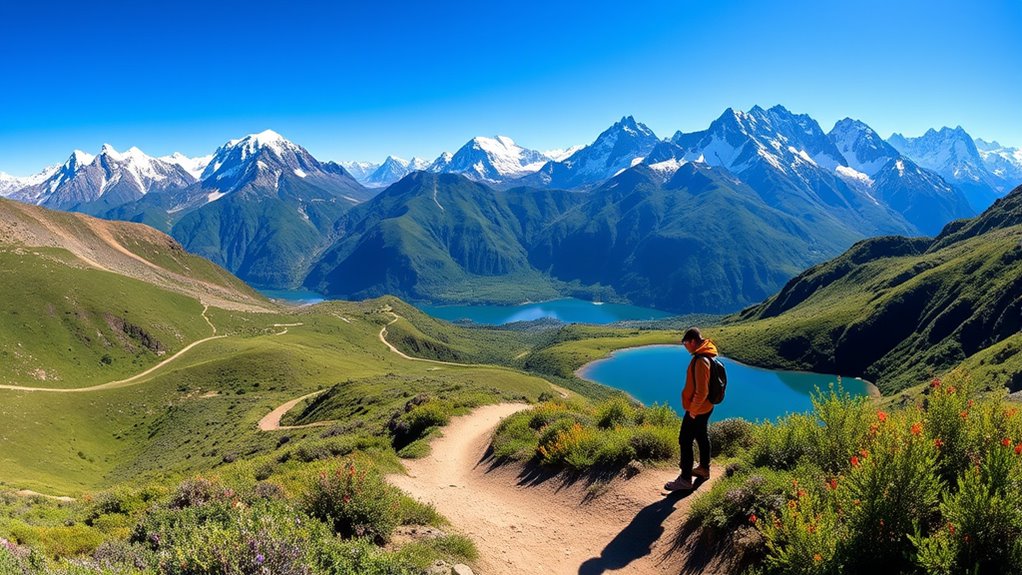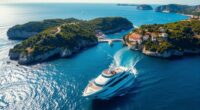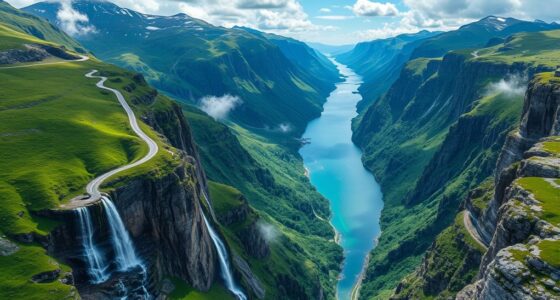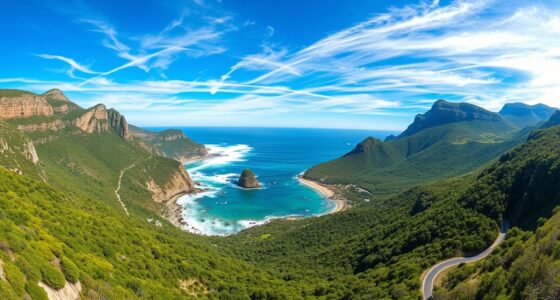Explore a mesmerizing 14-day journey from Peru’s ancient Machu Picchu and Cusco to Chile’s stunning Atacama Desert. You’ll experience impressive Inca sites, vibrant indigenous cultures, and surreal landscapes like salt flats and volcanic valleys. As you travel through the Altiplano and coastal regions, you’ll enjoy local flavors, traditions, and natural wonders. Continue your adventure to uncover the rich history, diverse environments, and cultural treasures awaiting you along this unforgettable route.
Key Takeaways
- The journey spans Cusco, Machu Picchu, and the Sacred Valley, highlighting Inca heritage and architectural marvels.
- Travelers explore the Altiplano, salt flats, and border towns, experiencing diverse high-altitude landscapes and indigenous cultures.
- Northern Chile features the Atacama Desert’s geological wonders, lunar valleys, and vibrant indigenous craft markets.
- Cultural encounters include traditional music, festivals like Fiesta de La Tirana, and artisanal markets showcasing local crafts.
- The itinerary transitions from Andean mountains to coastal cities, offering cuisine, coastal attractions, and historic sites across Chile.
Exploring the Mysteries of Machu Picchu and the Sacred Valley
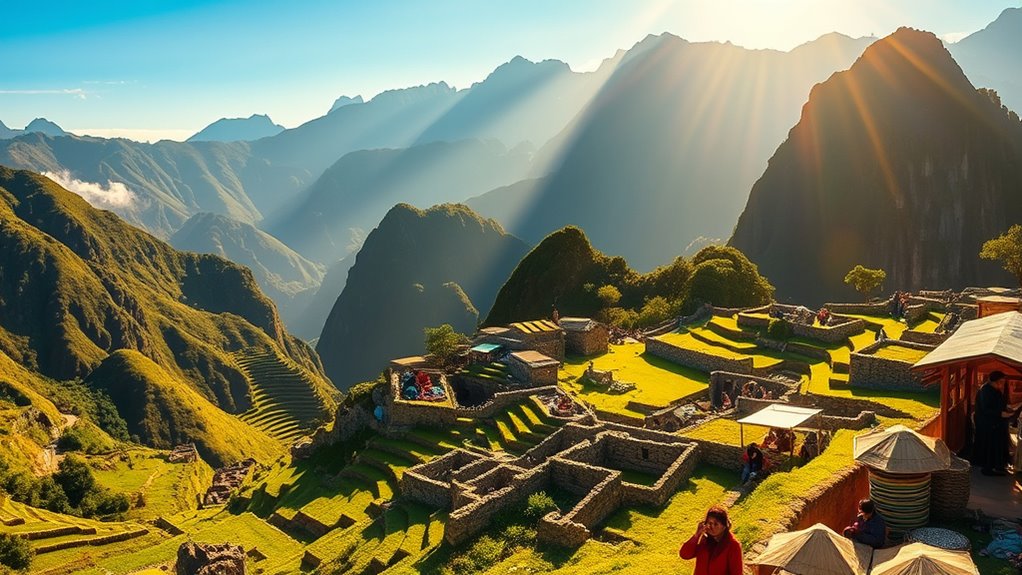
Nestled high in the Peruvian Andes, Machu Picchu continues to captivate visitors with its mysterious ruins and breathtaking views. As you explore this ancient citadel, you’ll sense the ingenuity of the Inca civilization, marveling at precisely cut stones that have withstood centuries. The terraces and temples reveal a sophisticated understanding of astronomy and agriculture. Walking through the site, you might imagine the lives of those who built it, feeling the spiritual energy that still lingers. Just below, the Sacred Valley stretches out with lush landscapes and vibrant local markets. This region offers a glimpse into Inca culture and history, inviting you to connect with a civilization that mastered architecture, engineering, and harmony with nature.
Cusco: The Historic Heart of the Andes
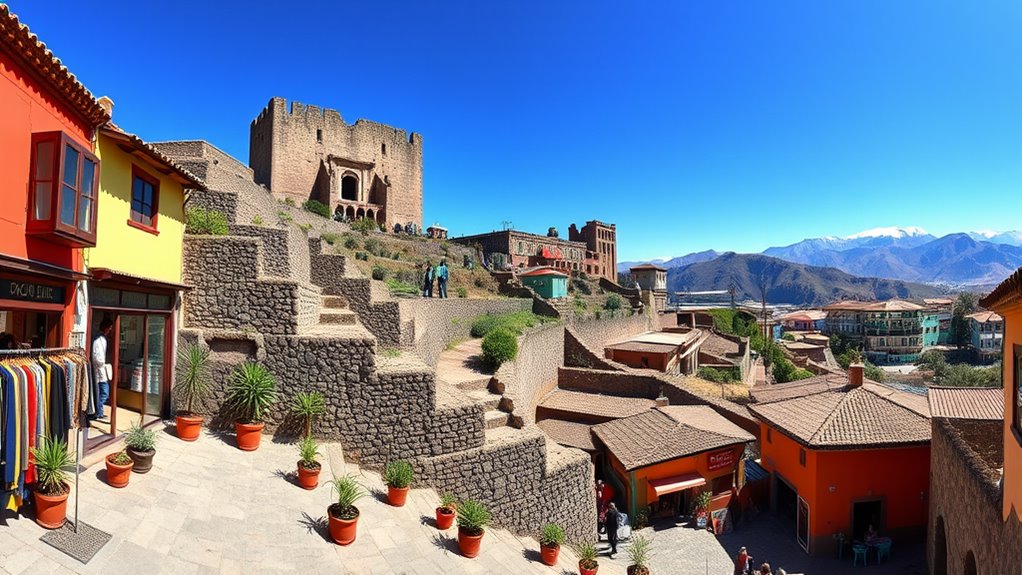
Cusco, once the proud capital of the Inca Empire, remains the vibrant cultural and historical heart of the Andes. As you explore its cobblestone streets, you’ll see ancient Inca walls blending seamlessly with colonial architecture. Visit the impressive Sacsayhuamán fortress, where massive stone blocks demonstrate Inca engineering prowess. Don’t miss the Cathedral of Cusco, home to stunning religious art and gilded altars. The city’s lively markets, like San Pedro, offer a glimpse into local life and crafts. Cusco’s vibrant atmosphere invites you to immerse yourself in its rich history, vibrant traditions, and colorful festivals. Whether wandering through archaeological sites or sampling traditional cuisine, you’ll feel connected to the enduring legacy of the Incas and the enduring spirit of the Andes. Mastering traditional Inca construction techniques can deepen your appreciation for the remarkable engineering achievements seen throughout the region. Exploring archaeological sites further enhances understanding of the ancient engineering methods used by the Incas, and gaining knowledge of traditional building materials can provide valuable insights for preservation and reconstruction efforts. Additionally, understanding the vibrational energy of the area can help visitors connect more deeply with the spiritual significance of Cusco.
Journey Through the Altiplano and the Bolivian Borderlands
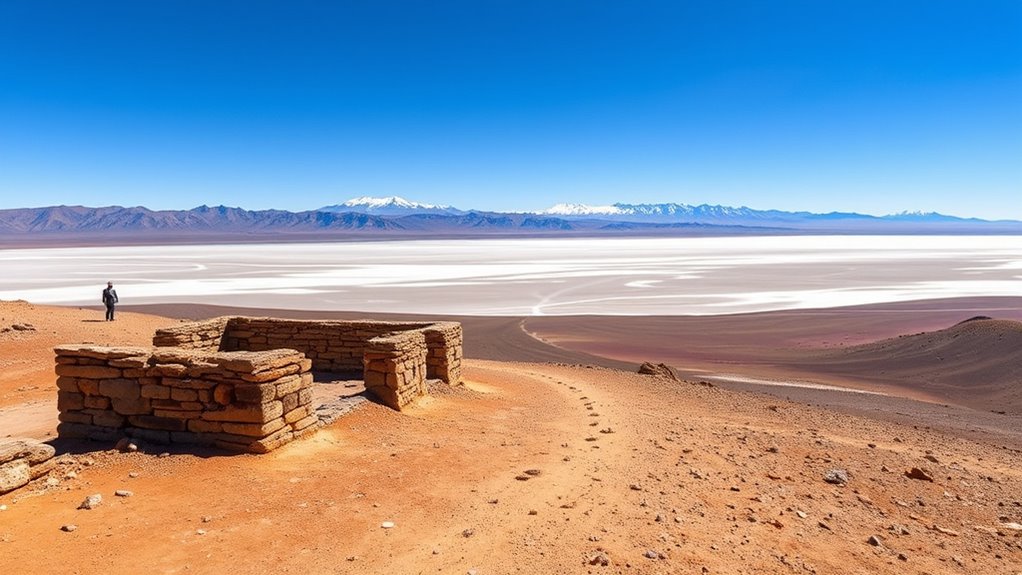
As you leave the lush highlands of Cusco behind, your journey takes you across the vast, arid expanse of the Altiplano, a high plateau that stretches between the Andes of Peru and Bolivia. The landscape shifts dramatically, with salt flats, volcanic peaks, and sparse vegetation creating a stark, surreal scenery. You’ll pass through small border towns, where local markets offer colorful textiles and handmade crafts. The air grows thinner and cooler as you ascend, and you might see flamingos wading in the salt lakes. The Altiplano’s quiet, expansive beauty invites reflection. As you cross into Bolivia, the landscape remains rugged and remote, setting the stage for the next leg of your adventure through this high-altitude wilderness. This remote terrain underscores the importance of secure payment processing options for local businesses in the region. Additionally, the region’s altitude challenges can impact travelers and local agriculture alike, emphasizing the need for proper preparation and adaptation strategies. The extreme elevation can also influence health considerations, making awareness crucial for visitors and residents. Recognizing behavior patterns related to health and safety is essential in such isolated environments.
Discovering the Deserts and Valleys of Northern Chile
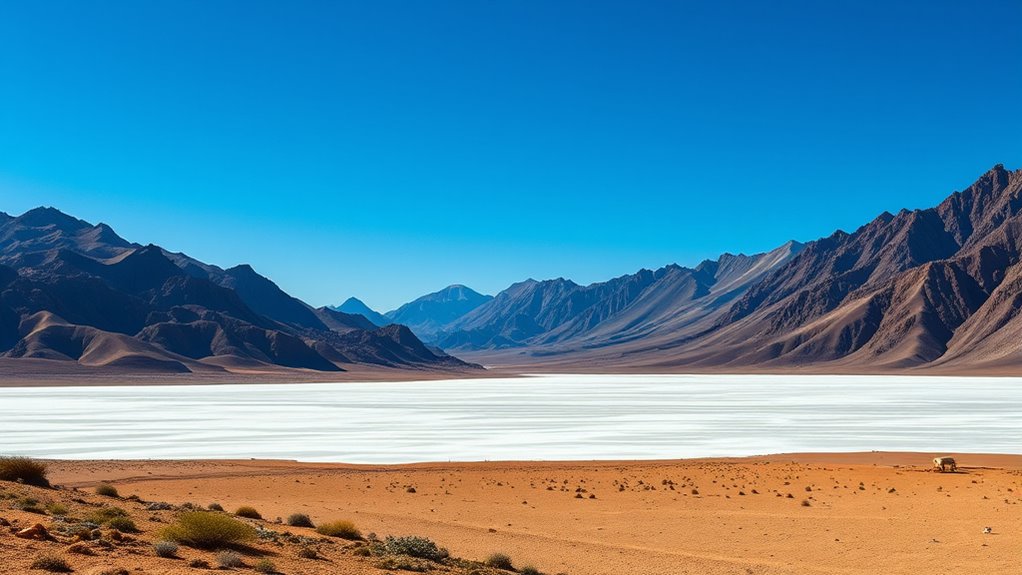
As you explore northern Chile, you’ll be captivated by the breathtaking landscapes of the Atacama Desert and vibrant valleys. These areas reveal stunning natural wonders and rich terrain that tell unique stories. Get ready to experience some of the most striking scenery on your journey. Incorporating market research can help you better understand the best spots to visit and how to appreciate these landscapes through the lens of traveler interests. Being aware of regional resources and tools can also enhance your experience, ensuring you find the most scenic and meaningful sites to explore. Additionally, understanding the region’s biodiversity can deepen your appreciation for the unique ecosystems present in these desert and valley environments. Moreover, familiarizing yourself with the local community engagement can enrich your journey by fostering meaningful interactions with residents and learning about their cultural heritage.
Atacama Desert Wonders
The Atacama Desert stands out as one of the most otherworldly landscapes on Earth, offering a striking combination of salt flats, volcanic formations, and colorful valleys. As you explore, you’ll encounter vast salt flats like the Salar de Atacama, home to flamingos and unique mineral deposits. Towering volcanoes, such as Licancabur and Lascar, dominate the skyline, showcasing Earth’s volcanic activity. The desert’s surreal landscapes include vibrant geodes and mineral-rich hills, revealing nature’s vivid palette. You might also visit the Valle de la Luna, where eroded formations resemble a lunar surface, perfect for sunset views. The dry climate and clear skies make the Atacama a prime spot for stargazing, offering some of the best astronomical observations on the planet. Incorporating natural materials like stone and mineral elements in nearby accommodations can enhance the authentic experience of the region.
Valleys’ Rich Landscapes
Northern Chile’s valleys and deserts showcase an impressive array of landscapes that captivate travelers. As you explore, you’ll encounter lush, green valleys like the Valle de la Luna, which contrasts sharply with the surrounding arid terrain. The fertile lands of the Elqui Valley invite you to taste locally produced wines and enjoy clear night skies perfect for stargazing. The Altiplano region offers dramatic vistas, where high-altitude salt flats meet rugged canyons. These landscapes are not just beautiful—they tell stories of geological history and ancient cultures. You’ll feel the stark beauty of the desert juxtaposed with vibrant oases and vibrant towns. Every turn reveals new textures, colors, and perspectives, making your journey through these valleys and deserts an unforgettable experience of nature’s diversity. Additionally, understanding the geological formations of these areas enhances appreciation of their unique features and history, revealing insights into the geological processes that shaped them over millennia. Exploring these landscapes also provides a window into the geological history, which has influenced human settlement and cultural development in the region. Recognizing the geological features helps deepen your connection to the land’s natural story and its ongoing evolution.
The Enchanting Landscapes of the Atacama Desert
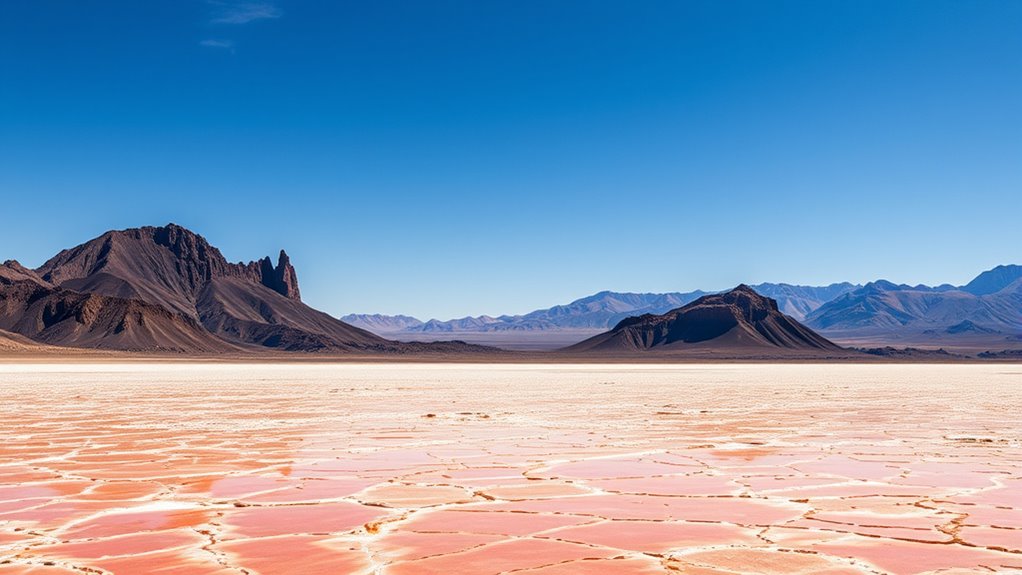
Few places on Earth captivate the imagination quite like the Atacama Desert, with its otherworldly landscapes and stunning variety of colors. You’ll marvel at vast salt flats shimmering under the sun, jagged volcanoes piercing the sky, and surreal, moon-like terrain. The desert’s unique features create a silent, almost mystical atmosphere that pulls you in.
| Landmark | Description | Experience |
|---|---|---|
| Valle de la Luna | Eroded rock formations resemble lunar landscapes | Walk through breathtaking scenery |
| Salar de Atacama | Largest salt flat, home to flamingos | Capture stunning photos |
| Geysers del Tatio | Boiling geysers at dawn | Feel the raw power of nature |
| Altiplanic lagoons | Vibrant, high-altitude lakes | Spot flamingos and other wildlife |
| Volcano Licancabur | Iconic volcano with ancient ruins | Enjoy panoramic views |
Cultural Encounters and Local Flavors in Northern Chile
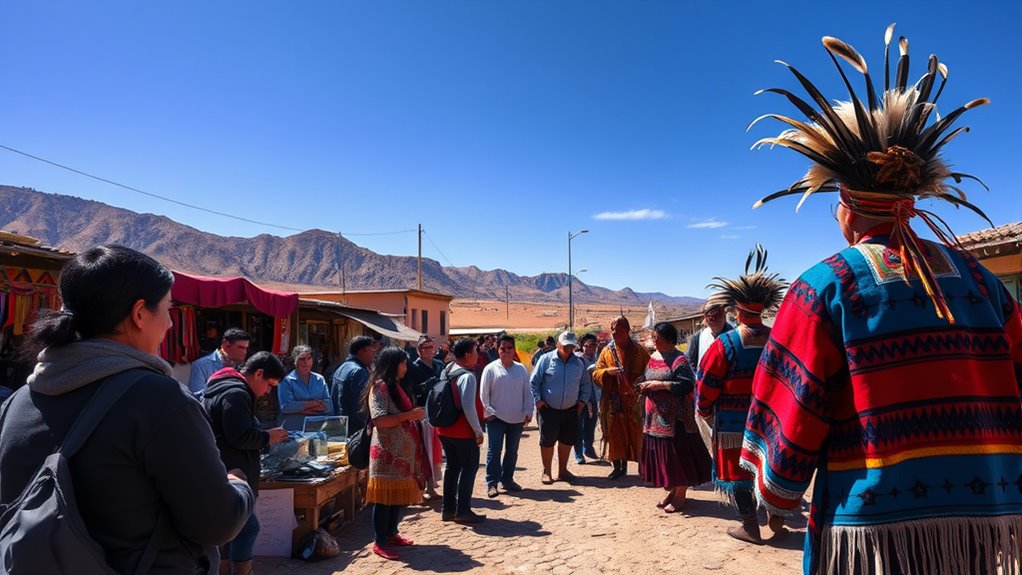
As you explore northern Chile, you’ll experience rich indigenous traditions and vibrant local arts that shape the region’s identity. Tasting authentic Chilean cuisine reveals unique flavors influenced by history and geography, offering a true sensory journey. Don’t miss the lively festivals and music that bring communities together and celebrate their cultural heritage. Additionally, the region’s commitment to sustainable energy, including the adoption of hydrogen fuel cell technology, highlights its dedication to environmentally friendly development. Incorporating innovative plant care solutions into local practices reflects the region’s embrace of eco-conscious advancements and sustainability. Exploring self watering plant pots can also enhance local gardening efforts, making plant care more efficient and accessible for communities dedicated to sustainability. Emphasizing community-led initiatives further demonstrates the region’s proactive approach to sustainable growth and cultural preservation.
Indigenous Traditions and Arts
When exploring the rich cultural landscape of northern Chile, you’ll encounter vibrant indigenous traditions and striking arts that have endured through generations. The Aymara and Atacameña peoples have preserved unique crafts, from intricate textiles to pottery adorned with symbolic patterns. You’ll notice colorful weavings that tell stories of their history and beliefs, often crafted using traditional techniques passed down over centuries. In local markets, artisans display handcrafted jewelry, textiles, and ceramics that reflect their deep connection to nature and spirituality. Recognizing the importance of cultural preservation is essential when engaging with these cultural expressions, as it allows for a deeper appreciation and understanding of their significance. Incorporating cultural artifacts into your interactions can foster respect and a more meaningful experience. Music and dance also play crucial roles, with lively performances featuring traditional instruments like the sikus (panpipes) and drums. These artistic expressions offer a window into the indigenous worldview, celebrating resilience while enriching the region’s cultural identity. Understanding the role of traditional arts helps visitors appreciate how these practices serve as a bridge between past and present, ensuring the continuation of their cultural legacy.
Authentic Chilean Cuisine
Exploring northern Chile means immersing yourself in a vibrant culinary scene shaped by centuries of indigenous traditions and diverse cultural influences. You’ll discover dishes that reflect the region’s desert landscapes and coastal bounty. Try the famous empanadas filled with cheese, seafood, or pino, a savory mix of meat and spices. Don’t miss “Cazuela,” a hearty stew with vegetables, chicken, or beef, flavored with local herbs. You’ll taste fresh seafood like congrio (conger eel), often prepared grilled or in stews. The region’s unique flavors are enhanced by ingredients like llama meat and native potatoes. Each bite offers a glimpse into the area’s rich history and cultural blending, creating a memorable culinary experience rooted in tradition yet evolving with modern influences. Additionally, regional ingredients play a crucial role in defining the authentic taste of northern Chilean cuisine, with Indigenous ingredients such as native potatoes and herbs adding distinctive flavors. Exploring local culinary techniques further enriches your understanding of the region’s food heritage.
Local Festivals and Music
Northern Chile’s vibrant festivals and lively music scenes offer a dynamic glimpse into the region’s rich cultural tapestry. When you attend local celebrations, you’ll experience colorful parades, traditional dances like the cueca, and spirited performances that showcase indigenous and mestizo traditions. Music pulses through the streets, with genres blending folkloric tunes and modern influences. During festivals such as the Fiesta de La Tirana, you’ll see dancers in elaborate costumes and hear lively drumming that energizes the atmosphere. These events provide more than entertainment—they’re opportunities to connect with local customs and community spirit. Whether you’re joining a dance circle or simply soaking in the melodies, you’ll gain a deeper appreciation for northern Chile’s cultural vibrancy and the stories it tells through sound and celebration. AI security technology can also enhance the safety and organization of these large public events, ensuring a secure environment for all attendees. Engaging with local traditions and understanding their significance can enrich your experience and foster a greater respect for the region’s unique heritage.
Extending the Adventure: From the Andes to the Pacific Coast
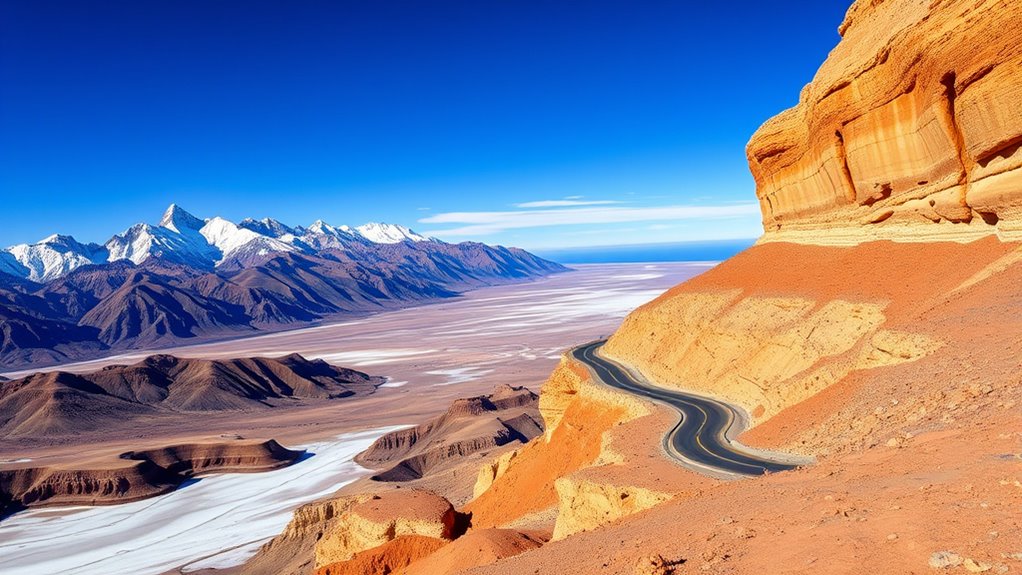
As you descend from the towering peaks of the Andes, the landscape shifts dramatically from rugged mountains to the sprawling coastal plains. You’ll feel the air warm and the scenery open up, revealing vibrant cities and quiet fishing villages along the Pacific coast. This changeover offers a striking contrast, blending high-altitude adventures with seaside relaxation. To help visualize your journey, here’s a quick overview:
| Location | Highlights | Activities |
|---|---|---|
| Arequipa | Colonial architecture | City tours, museums |
| Nazca Lines | Mysterious geoglyphs | Aerial flights, sightseeing |
| Paracas | Wildlife and marine reserves | Boat tours, birdwatching |
| Lima | Coastal metropolis | Gastronomy, historic sites |
| Valparaíso | Artistic port city | Street art, cultural tours |
Frequently Asked Questions
What Are the Best Months to Visit This Route?
You want to know the best months to visit this route. Typically, the ideal time is during the Southern Hemisphere’s spring and fall, from March to May and September to November. During these months, you’ll enjoy milder weather, fewer tourists, and better travel conditions. Avoid the peak summer months of December to February, as it can get crowded and hot, especially in popular destinations along the route.
Are There Any Safety Tips for High-Altitude Travel?
When traveling at high altitudes, you should stay hydrated, avoid alcohol, and take it slow to prevent altitude sickness. Listen to your body and rest if you feel dizzy or short of breath. Consider medications like acetazolamide if recommended. Always ascend gradually, and spend a night at intermediate altitudes to acclimate. Carry a basic first aid kit and be aware of local emergency numbers for safety.
How Do Local Customs Differ Between Peru and Chile?
You’ll notice that local customs in Peru and Chile differ quite a bit. In Peru, you’re often greeted with warm handshakes and might see traditional clothing during festivals. Chileans tend to be more reserved initially but value punctuality and direct communication. When visiting, respect local traditions, such as offering a small gift or greeting with a handshake or cheek kiss, depending on the setting. Embrace these differences to enrich your experience.
What Unique Wildlife Can Travelers Expect to See?
Get ready to witness wildlife that seems straight out of a dream! In Peru, you’ll marvel at majestic condors soaring above the Andes and playful Amazon river dolphins dancing in the rainforest. As you cross into Chile, expect to see the rare, otherworldly desert foxes in the Atacama and vibrant flamingos wading through shimmering salt flats. This journey immerses you in a world of extraordinary creatures that will leave your heart pounding with excitement.
Are There Recommended Souvenirs or Local Products to Buy?
When shopping for souvenirs, you’ll find plenty of unique items to bring home. Consider buying traditional textiles, handcrafted jewelry, or local art to capture the region’s culture. You might also enjoy tasting and purchasing regional foods like Peruvian coffee or Chilean wine. Don’t forget to explore local markets for authentic crafts and souvenirs that reflect the vibrant traditions and craftsmanship of the area, making your trip even more memorable.
Conclusion
As you complete this 14-day journey from Peru to Chile, you’ll carry unforgettable memories, like wandering through Machu Picchu’s ancient stones or tasting the vibrant flavors of local markets. Imagine standing in the Atacama Desert at sunset, feeling truly connected to this diverse landscape. Just like travelers who’ve embraced these adventures, you’ll find that immersing yourself in these cultures and environments transforms your perspective, leaving you inspired long after the trip ends.
